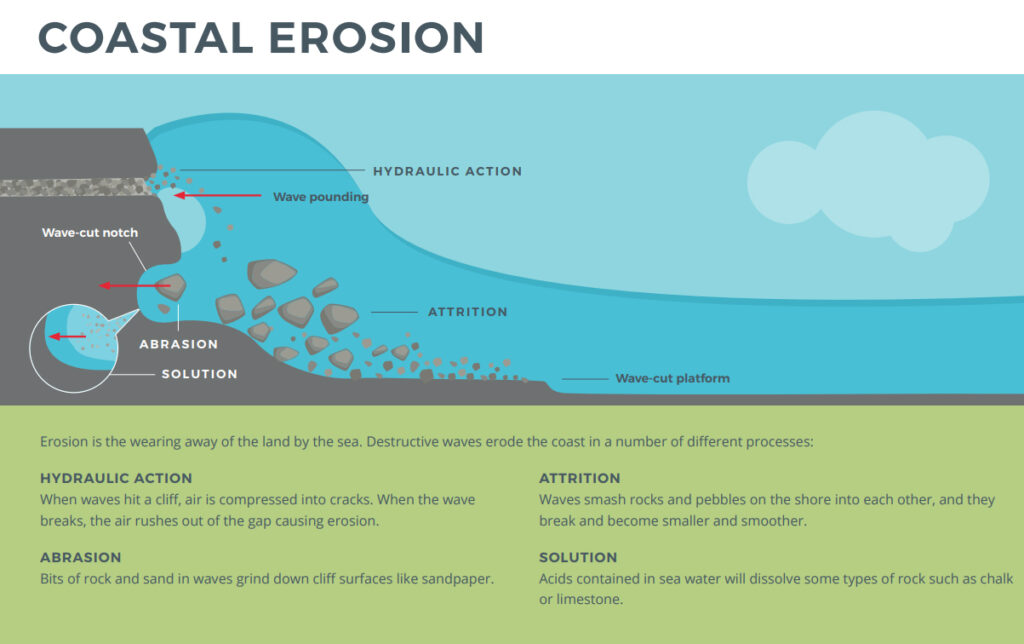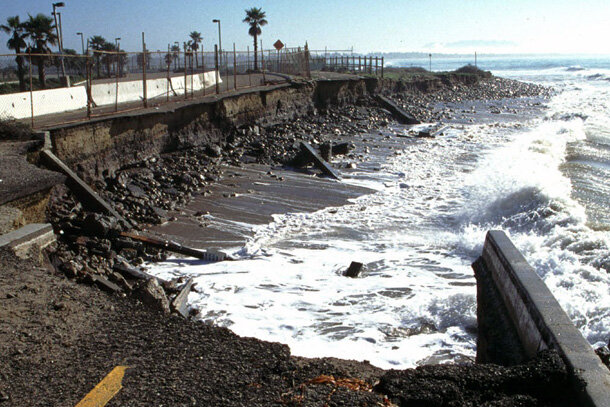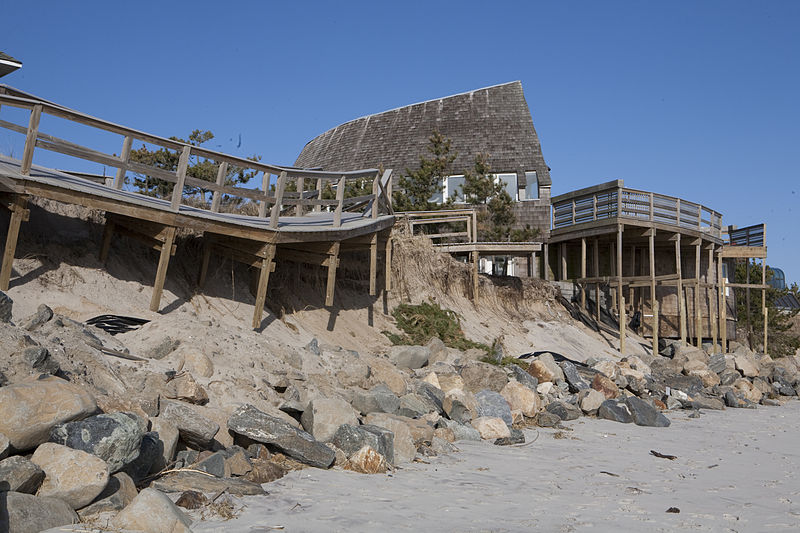Coastal erosion is the gradual wearing off of land and sediment removal along coastlines. It is a process driven by natural factors or human activities, which act as powerful forces reshaping the coastal landscape. Over time, the relentless action of these elements causes the coastline to recede, leading to the loss of sandy beaches, cliffs, and other coastal features.
In this article, we will learn about coastal erosions, how they can affect surf spots and surfing communities, and the proactive measures that we can implement to tackle this problem.
Coastal Erosion from Natural Factors

Source: NST Geography Trips
Coastlines are naturally shaped over time, notwithstanding man made structures that line the coast. This process can change the ocean floor underneath a surf break and significantly change how the waves there break.
Wind and currents drive waves that consistently exert force, gradually eroding the shoreline. Some events like hurricanes generate powerful storm surges with immense wave energy, accelerating a normally slow and invisible process. Changing tides also contribute to erosion by moving substantial amounts of water and sediment along the coast. Moreover, natural processes like longshore drift, where waves move sediment along the shoreline, can lead to the redistribution and loss of beach material.
These natural forces, combined with the geological characteristics of the coastline, influence the extent and rate of erosion in coastal areas, particularly in surf spots, where waves are more consistent and robust.
Coastal Erosion from Human Activities
Human activities are one significant factor that accelerates coastal erosion and worsens its impact. Building coastal structures like harbors, piers, and jetties disrupts natural sediment flow and alters coastal dynamics, leading to erosion in nearby areas. For example, a harbor’s construction can trap sediment, causing downstream deficits and increased erosion. Beachfront development and sand extraction from beaches deplete sediment sources, leaving coastlines more vulnerable to erosion. Additionally, deforestation and changes to rivers and streams impact sediment supply to the coast, further contributing to erosion.
Human activities driven by economic development and coastal management goals can unintentionally disrupt the natural movement of sediment, thereby increasing the risk of coastal erosion. This problem is common in surf spots, where there are developments to attract more tourists.
Impact of Coastal Erosion on Surf Spots

Source: Paul Jenkin/Surfrider Foundation
Coastal erosion significantly affects surf spots, changing their features and putting their long-term existence at risk. Here’s everything you need to know.
First, the loss of sand and sediment due to erosion can significantly impact the quality and quantity of waves. As the shoreline retreats, the sand for wave formation diminishes, resulting in flatter and weaker waves. Coastal erosion can also destroy natural features, such as rock formations and sandbars, which often contribute to forming quality waves by shaping the wave’s energy and creating desirable breaks. The loss of these natural coastal features affects the beach profile, potentially making it unsuitable for surfing altogether.
Lastly, coastal erosion can alter wave characteristics. As the coastline erodes, wave energy disperses differently, leading to wave direction, size, and shape shifts. These changes can transform once consistent surf breaks into unpredictable and less desirable conditions for surfing. This erosion-induced alteration of wave patterns can challenge surfers’ ability to ride the waves effectively.
Impact of Coastal Erosion on Surfing Communities

Source: Wikimedia Commons
Coastal erosion affects surf spots and directly impacts the communities that depend on surfing as a crucial aspect of their lifestyle and local economy. Let’s delve into how these effects can happen.
Impact on Surfing Communities’ Economy
Coastal erosion can have significant economic implications for local communities. Surfing attracts tourists who contribute to the local economy through spending on accommodations, food, and other services. However, when erosion diminishes the quality of waves or erodes sandy beaches, it can deter tourists from visiting, leading to a decline in tourism revenue.
Impact on Surfers’ Way of Life
Coastal erosion results in the loss of recreational opportunities for community members. Surfing is a sport and a way of life for many coastal communities. It brings people together, promotes physical activity, and fosters a sense of community pride. When surf spots are affected by erosion, it limits the ability of residents to engage in their beloved sport, leading to a loss of recreational enjoyment and potential negative impacts on the community’s well-being.
Impact on Infrastructures
Lastly, coastal erosion poses a serious threat to the vital infrastructure that sustains surfing communities, including businesses like surf shops, surf camps, restaurants, and resorts. As the coastline recedes, these structures face increased vulnerability to storm damage and rising sea levels. According to the National Oceanic Atmospheric Administration (NOAA), coastal erosion in the US incurs an annual damage cost of approximately 500 million USD. This situation is particularly concerning for surfing communities, given their proximity to the coast, as it heightens the risk of property loss, job displacement, and business disruptions, potentially necessitating costly measures to mitigate the impact.
Examples of Proactive Measures to Address Coastal Erosion
There are proactive measures that can protect coastal communities, infrastructure, and ecosystems from the harmful impacts of coastal erosion. Implementing these measures ensures long-term sustainability in coastal areas. Here are some examples of proactive steps taken to address coastal erosion.
- Beach Nourishment: Beach nourishment involves the addition of sand or sediment to eroded beaches, replenishing the coastal system and providing a buffer against future erosion. For instance, large-scale beach nourishment projects have been implemented in Miami Beach, Florida, to restore eroded shorelines, protect coastal infrastructure, and maintain tourism.
- Dune Restoration: Dunes are like natural shields against erosion. They soak up the power of waves and keep inland areas safe from strong surges during storms. Restoring dunes means planting plants and reshaping the sand. In the Outer Banks, North Carolina, they effectively stabilized the dunes and prevented further erosion by planting native vegetation and adding fences.
- Breakwaters and Seawalls: These structures aim to reduce erosion and disperse wave energy along vulnerable coastlines. Breakwaters are submerged barriers built offshore, while seawalls are constructed along shorelines. The Netherlands’ Delta Works project is a remarkable example, featuring an extensive system of seawalls, storm surge barriers, and artificial islands, effectively protecting low-lying areas from erosion and flooding.
- Managed Retreat: In some cases, it may be necessary to relocate human settlements and infrastructure away from eroding coastlines. This approach, known as managed retreat, allows natural coastal processes to occur without significant human interference. For instance, in Isle de Jean Charles, Louisiana, a community severely affected by erosion and rising sea levels, authorities have offered residents the opportunity to relocate to more stable inland areas.
- Vegetation Restoration: Planting and restoring coastal vegetation like mangroves, salt marshes, and seagrasses benefits coastal areas and nearby surf spots. These habitats stabilize the soil, absorb the power of waves, and trap sediment, which lowers the erosion rate. A great example is the restoration of mangroves in Thailand’s coastal areas after the 2004 tsunami. It showed how improving coastal ecosystems can help prevent erosion and safeguard communities.
- Integrated Coastal Zone Management: A comprehensive and collaborative approach, integrated coastal zone management aims to balance ecological, economic, and social interests in coastal areas. It involves careful planning, zoning, and regulation to address erosion issues holistically. The European Union’s ICZM Directive has been instrumental in promoting sustainable coastal development and erosion management along Europe’s coastlines.
By implementing effective strategies like these in areas most needed, we can achieve two crucial goals: safeguarding coastal regions for the long run and providing vital support to surfing communities by protecting their surf spots. These efforts can help maintain the quality and quantity of waves, preserve natural coastal features, and boost the well-being of surfers and their local economy. This collective action paves the way for a resilient future for the environment and the people who call these coastal regions home.